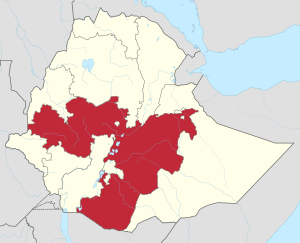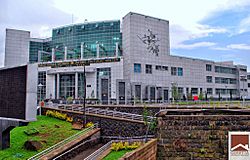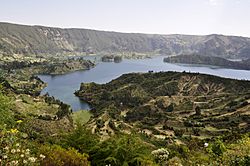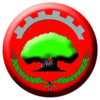Oromia facts for kids
Quick facts for kids
Oromia
Oromiyaa
|
|||
|---|---|---|---|
|
Regional state
|
|||
|
From top, left to right:
Oromia Cultural Center, Irreechaa, Sof Omar Caves, Wonchi Lake, Bale Mountains National Park and Lake Shalla |
|||
|
|||

Map of Ethiopia showing Oromia
|
|||
| Country | |||
| Official language | Oromo | ||
| Capital | Addis Ababa (Finfinne) | ||
| Area | |||
| • Total | 353,690 km2 (136,560 sq mi) | ||
| Area rank | 1st | ||
| Population
(2017)
|
|||
| • Total | 35,467,001 | ||
| • Rank | 1st | ||
| • Density | 100.267/km2 (259.69/sq mi) | ||
| Demonym(s) | Oromo or Oromian | ||
| Time zone | EAT | ||
| ISO 3166 code | ET-OR | ||
| HDI (2021) | 0.482 low · 8th of 11 |
||
Oromia (Amharic: ኦሮሚያ) (Oromo: Oromiyaa) is a large regional state in Ethiopia. It is the home of the Oromo people. The capital city of Oromia is Addis Ababa, also known as Finfinne.
Oromia shares borders with many other regions in Ethiopia. To the east, it borders the Somali Region. To the north, it borders the Amhara Region, the Afar Region, and the Benishangul-Gumuz Region. Dire Dawa is to the northeast. To the west, it borders South Sudan, Gambela Region, South West Ethiopia Region, Southern Nations, Nationalities, and Peoples' Region, and Sidama Region. To the south, it borders Kenya. The city of Addis Ababa is like an island in the middle of Oromia.
In 2017, Oromia had about 35.5 million people. This makes it the largest regional state in Ethiopia by population. It is also the largest regional state in terms of land area, covering about 353,690 square kilometers. Oromia is the most populated subnational area in all of Africa.
Contents
History of Oromia
The Oromo people are one of the oldest groups living in the Horn of Africa. They are part of the Cushitic peoples. Many signs suggest they have lived in what is now northern Kenya and southeastern Ethiopia for over 7,000 years. Around 1520, they expanded into new areas, moving southwest and north.
Oromia's Independence and Challenges
The Oromo people and their land, Oromia, were independent for a long time. This changed in the late 1800s. From 1881 to 1886, Emperor Menelik II tried to take over their land. The Arsi Oromo group fought back very strongly. They faced an enemy with modern European guns. Even so, they were finally defeated in 1886.
In the 1940s, some Oromo people joined a movement that was against the rule of the Amhara Christian group. The Ethiopian government stopped these movements with force. In the 1970s, some Oromo groups formed alliances with Somalia.
Protecting Oromo Culture and Language
In 1967, the government of Emperor Haile Selassie I banned an Oromo social group called the Mecha and Tulama Self-Help Association. Many of its members were arrested or executed. This made the Oromo community very angry. It led to the creation of the Oromo Liberation Front in 1973. The Oromo people felt that the Emperor's rule was unfair. The Oromo language was not allowed in schools or government. People who spoke Oromo were often made fun of. The Amhara culture was dominant during this time.
Later, both the imperial government and the Derg government moved many Amharas into southern Ethiopia, including Oromia. This was partly to help with drought in the north. These new settlers also worked in government, courts, and churches. Oromo texts in schools were replaced with Amharic. This made it harder for Oromo culture to thrive.
Recent Changes and Protests
In the early 1990s, the Ethiopian government started to lose power. The Oromo Liberation Front (OLF) struggled to work with other rebel groups. In 1990, a new group called the Ethiopian People's Revolutionary Democratic Front (EPRDF) was formed. The EPRDF created its own Oromo group, the Oromo People's Democratic Organization (OPDO). Many saw this as a way to reduce the OLF's power.
In 1991, the EPRDF took control and formed a new government. The OLF and EPRDF tried to work together, but it was difficult. The OLF felt their members were being bothered and even killed. In 1992, the OLF left the government. The EPRDF then attacked OLF camps. The OLF had to switch to guerrilla warfare because the EPRDF had more soldiers and better weapons. By the late 1990s, most OLF leaders had left Ethiopia. The Ethiopian government, led by the EPRDF, took control of the land the OLF once managed.
The city of Addis Ababa was originally called Finfinne in the Oromo language. This name means "hot springs." The area was home to different Oromo clans before the city was built.
In 2000, Oromia's capital was moved from Addis Ababa to Adama. This caused many protests from Oromo students. Because of this, in 2005, the OPDO announced that the capital would be moved back to Addis Ababa.
More protests happened in 2014 and 2015 against a plan for Addis Ababa. These protests continued into 2016 across Oromia. Many protesters were killed, and internet service was cut off. In 2019, the Irreecha festival, an important Oromo celebration, was held in Addis Ababa. This was the first time in 150 years that it was allowed there.
Geography of Oromia
Oromia includes parts of several older provinces of Ethiopia. It borders almost every other region in Ethiopia, except for the Tigray Region. Sometimes, there have been disagreements about the borders, especially between Oromia and the Somali Region. In 2004, a vote was held to help solve one of these border disputes. Most of the disputed areas then came under Oromia's control.
Many towns are located in Oromia. Some of these include Adama, Ambo, Asella, Jimma, Nekemte, and Shashamane.
People and Culture
Population and Living Standards
In 2007, Oromia had a population of about 27 million people. About 11% of the people lived in cities, while most lived in rural areas. By 2017, the population had grown to over 35 million.
In 2004, about 32% of people in Oromia had access to safe drinking water. This was higher in cities than in rural areas. In 2005, about 19.9% of people were in the lowest wealth group. For adults, about 61.5% of men and 29.5% of women could read and write.
Ethnic Groups in Oromia
The main ethnic group in Oromia is the Oromo. In 2007, about 88% of the population was Oromo. The next largest group was the Amhara, making up about 7% of the population. Other ethnic groups made up the remaining 5%.
Religions in Oromia
Oromia has a mix of religions. In 2007, the largest religious group was Muslims, making up about 48% of the population. Orthodox Christians were about 30%. Protestant Christians made up about 18%. About 3% followed Waaqeffanna, an traditional Oromo religion. Other religious groups made up about 1%.
In urban areas, Orthodox Christians were the largest group, followed by Muslims and Protestant Christians.
Languages Spoken in Oromia
The Oromo language is very important in Oromia. It is written using Latin letters, called Qubee. This writing system was officially adopted in 1991.
Oromo is one of the official working languages of Ethiopia. It is also the main working language in Oromia and some other regional states like Harari and Dire Dawa. It is used for primary education in these areas. Oromo is also used on federal websites.
More than 33.8% of people in Ethiopia speak Oromo. It is the most widely spoken language in Ethiopia. It is also the most widely spoken Cushitic language and the fourth most spoken language in Africa. Over 35 million Oromo people in Ethiopia speak it as their first language. Many people from other ethnic groups also learn Oromo as a second language because they live near Oromo communities.
Economy of Oromia
Oromia plays a big role in Ethiopia's economy. It is a major source of Ethiopia's main exports. These include gold, coffee, khat, and cattle. The Lega Dembi Mine in the Guji Zone has exported over 5,000 kilograms of gold. Another important gold deposit is Tulu Kapi in the West Welega Zone. Awoday, in the East Hararghe Zone, is a large market for khat, which is exported to Djibouti and Somalia.
Oromia has more livestock than any other region in Ethiopia, including camels. It is also the largest producer of cereals (like grains) and coffee. From 2004 to 2005, Oromia produced over 115,000 tons of coffee. This was more than half of Ethiopia's total coffee production. Farmers in Oromia also had a large number of animals. This included over 17 million cattle, nearly 7 million sheep, and almost 5 million goats. They also had many horses, mules, donkeys, camels, poultry, and beehives.
In 2003, a report showed that rural households in Oromia had an average of 1.14 hectares of land. This was slightly more than the national average. About 24% of the population worked in jobs not related to farming.
Educational Institutions
- Adama University
- Ambo University
- Arsi University
- Dambi Dollo University
- Dandii Boruu University College
- Haramaya University
- Jimma Teachers College
- Jimma University
- Madda Walabu University
- Mattu University
- New Generation University College
- Oda Bultum University
- Oromia State University
- Rift Valley University College
- Wollega University
Leaders of Oromia Region
| Tenure | Portrait | Incumbent | Affiliation | Notes |
|---|---|---|---|---|
| 1992–1995 | Hassen Ali | OPDO | ||
| 1995 – 24 July 2001 | Kuma Demeksa | OPDO | ||
| July 2001 – October 2001 | Position vacant | |||
| 28 October 2001 – 6 October 2005 | Junedin Sado | OPDO | ||
| 6 October 2005 – September 2010 | Abadula Gemeda | OPDO | ||
| September 2010 – 17 February 2014 | Alemayehu Atomsa | OPDO | ||
| 27 March 2014 – 23 October 2016 | Muktar Kedir | OPDO | ||
| 23 October 2016 – 18 April 2019 |  |
Lemma Megersa | OPDO/ODP | |
| 18 April 2019 – present |  |
Shimelis Abdisa | ODP/PP |
Administrative Zones
Oromia is divided into 21 administrative zones. These zones are then divided into smaller areas called districts (weredas). Each zone has its own main town or capital.
Images for kids
See also
 In Spanish: Región de Oromía para niños
In Spanish: Región de Oromía para niños


















